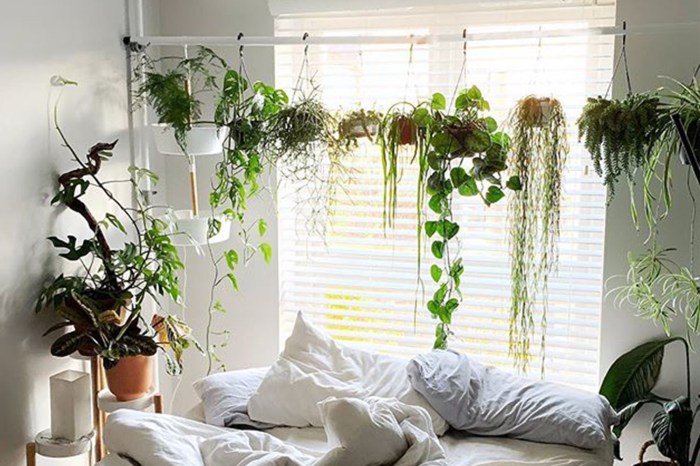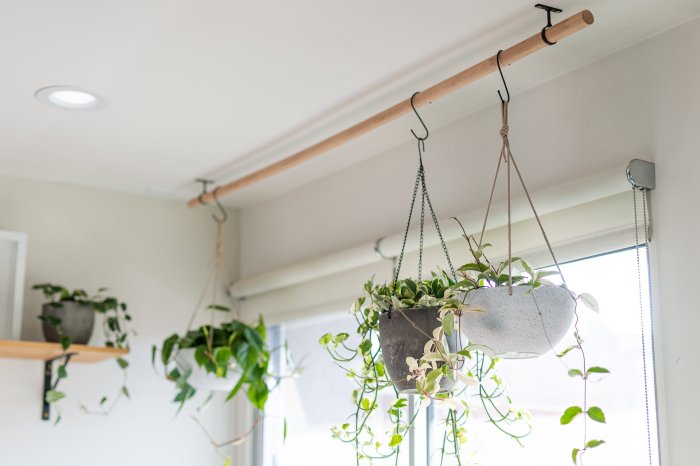Hanging plant rod indoor – Hanging plant rods are taking center stage in modern interiors, offering a stylish and practical way to bring nature indoors. From adding a touch of greenery to maximizing space, these versatile rods transform any room into a botanical paradise.
Whether you’re a seasoned plant enthusiast or just starting your indoor gardening journey, this guide will provide you with comprehensive insights into hanging plant rods, from design considerations to creative uses and troubleshooting tips.
Design Considerations for Hanging Plant Rods

Selecting the right hanging plant rod is essential to ensure the health and aesthetic appeal of your indoor plants. Here are some key design considerations to keep in mind:
Materials
The choice of rod material depends on the weight of the plants and the indoor conditions. Metal rods are durable and can support heavier plants, but they can be prone to rust in humid environments. Wood rods are more susceptible to moisture damage but add a natural touch to the space.
Plastic rods are lightweight and affordable, but they may not be as sturdy as metal or wood.
Design
Hanging plant rods come in a variety of designs, including straight, curved, and adjustable. Straight rods provide a clean and minimalist look, while curved rods add a touch of elegance. Adjustable rods allow you to customize the length and height of the rod to accommodate different plant sizes and ceiling heights.
Length and Placement
The optimal length and placement of the rod depend on the size of the plants and the amount of light exposure desired. Longer rods provide more space for plants to hang, while shorter rods are better suited for smaller plants or areas with limited space.
Place the rod in a location that receives ample sunlight, but avoid direct sunlight, which can scorch the leaves.
Hanging plant rods are a popular choice for indoor gardening, providing a stylish and practical way to display plants. They can be used to hang a variety of plants, including trailing plants , which are known for their long, cascading stems.
Trailing plants are perfect for adding a touch of greenery to any room, and they can also help to purify the air. Hanging plant rods come in a variety of styles and sizes, so you can find one that fits your décor and needs.
Installation and Maintenance of Hanging Plant Rods
Ensuring the secure installation and proper maintenance of hanging plant rods is crucial for both the safety of your plants and the longevity of the rods themselves. This section will provide a comprehensive guide to installing and maintaining hanging plant rods, including step-by-step instructions and recommendations for hardware and cleaning.
Before beginning any installation, it is important to choose the appropriate mounting hardware for the surface you will be installing on. For drywall or plaster ceilings, hooks or anchors specifically designed for this purpose should be used. For wooden ceilings or beams, brackets or screws can be used directly into the wood.
Step-by-Step Installation Instructions
- Determine the desired location for your hanging plant rod and mark the spots where the mounting hardware will go.
- Install the mounting hardware according to the manufacturer’s instructions, ensuring it is securely fastened.
- Hang the plant rod onto the mounting hardware and adjust the height as needed.
- Securely fasten the plant rod to the mounting hardware, using any necessary bolts or screws.
Maintaining Your Hanging Plant Rods
To ensure the longevity of your hanging plant rods, regular cleaning and maintenance are essential. Here are some recommendations:
- Wipe down the rods regularly with a damp cloth to remove dust and dirt.
- If the rods become rusty or corroded, use a mild cleaning solution and a soft brush to remove the rust or corrosion.
- Apply a thin layer of oil or wax to the rods to protect them from further rust or corrosion.
Plant Selection and Display for Hanging Rods
Choosing suitable plants and arranging them effectively on hanging rods is crucial for creating a visually appealing and thriving indoor greenery display. Factors to consider include plant size, growth habit, and light requirements.
Hanging plant rods for indoor spaces are a great way to add greenery and life to any room. With their ability to accommodate small trailing indoor plants , these rods provide a convenient and stylish way to display your favorite foliage.
Whether you’re looking for a simple way to add a touch of nature to your living room or a more elaborate display for your office, hanging plant rods are a versatile solution that can transform any space.
Plant Selection, Hanging plant rod indoor
When selecting plants for hanging rods, consider their mature size to ensure they fit the available space. Choose plants with a cascading or trailing growth habit, such as pothos, spider plants, or ferns, to create a lush and flowing effect.
Light requirements are also essential. Determine the amount of natural light available in the hanging area and select plants that can tolerate the conditions. For low-light areas, opt for plants like snake plants or ZZ plants.
Plant Arrangement
Create visually interesting arrangements by using multiple hanging rods at different heights and angles. This adds depth and dimension to the display. Stagger the plants to prevent overcrowding and allow each one to receive adequate light.
Plant Care
Proper watering and fertilization are crucial for maintaining plant health when suspended from rods. Water thoroughly until water drains from the drainage holes, but avoid overwatering. Fertilize plants monthly during the growing season with a balanced liquid fertilizer.
Creative Uses of Hanging Plant Rods

Hanging plant rods have transcended their traditional purpose, becoming versatile fixtures that add both functionality and style to indoor spaces. From displaying artwork to suspending lighting fixtures, these rods offer endless possibilities for creative expression.
Room Designs
In bohemian-inspired rooms, hanging plant rods adorned with trailing plants and macrame hangers create a relaxed and inviting atmosphere. Minimalist spaces can incorporate sleek rods with geometric planters to add a touch of greenery without cluttering the floor.
Art and Lighting
Beyond plants, hanging plant rods can showcase artwork by suspending framed pieces or canvases from the ceiling. They can also serve as unique lighting fixtures, holding Edison bulbs or pendant lights to create ambient illumination.
Storage Solutions
In small spaces or rooms with limited storage, hanging plant rods can be repurposed to hold baskets or containers. These can be used to store books, magazines, or other items, freeing up valuable floor space.
Troubleshooting Common Issues with Hanging Plant Rods
Hanging plant rods offer an elegant way to display greenery indoors, but they can occasionally encounter issues that affect their stability or plant health. By identifying common problems and implementing appropriate troubleshooting measures, plant enthusiasts can ensure their hanging plant rods remain functional and visually appealing.
Sagging or Instability
- Cause:Insufficient tension or weak mounts.
- Solution:Tighten the rod tension screws or reinforce the mounting hardware with additional anchors or supports.
Plant Damage
- Cause:Heavy plants or improper weight distribution.
- Solution:Use heavier-duty rods for larger plants or provide additional support, such as chains or cables, to distribute the weight more evenly.
Preventive Measures
To minimize the risk of accidents or plant damage, consider the following preventive measures:
- Use high-quality rods and mounting hardware that can withstand the weight of the plants.
- Install the rods securely, following the manufacturer’s instructions and using appropriate anchors for the wall type.
- Regularly check the rod tension and mounting hardware to ensure they remain secure.
Last Word

Incorporating hanging plant rods into your home is not just about aesthetics; it’s about creating a harmonious living space where nature and design intertwine. With careful planning and a touch of creativity, these rods can elevate your indoor greenery, bringing both beauty and functionality to your living environment.
FAQ Guide: Hanging Plant Rod Indoor
How do I choose the right hanging plant rod material?
Consider the weight of your plants and the indoor conditions. Metal rods are durable and sturdy, wood rods offer a natural aesthetic, and plastic rods are lightweight and budget-friendly.
How do I install hanging plant rods securely?
Use appropriate mounting hardware such as hooks, brackets, or anchors. Ensure the rods are securely attached to the ceiling or walls, and adjust the tension to prevent sagging.
What types of plants are best suited for hanging rods?
Trailing plants, such as pothos, ivy, and ferns, look stunning suspended from rods. Consider the plant’s size, growth habit, and light requirements when making your selection.